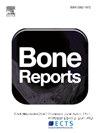Correlations between 6-minute walk test, chair-rise test, and lower extremity functional scale among patients with hypophosphatasia
IF 2.6
Q3 ENDOCRINOLOGY & METABOLISM
引用次数: 0
Abstract
Purpose
Hypophosphatasia (HPP) is a rare disease characterized by skeletal and nonskeletal manifestations that can increase patient disability. The 6-Minute Walk Test (6MWT) is frequently used to assess mobility in patients with HPP, although the test is laborious to conduct in clinical practice. The purpose of the current study was to determine correlations between time to complete the 6MWT, time to complete the Chair-Rise Test (CRT), and scores on the Lower Extremity Functional Scale (LEFS) in adults with HPP.
Methods
Pearson correlations between time to complete outcomes on the 6MWT and CRT, time to complete the 6MWT and scores on the LEFS, and time to complete the CRT and scores on the LEFS were calculated using de-identified data from adults with HPP who had first onset of symptoms in childhood. All patients were enrolled in the previously conducted, observational EmPATHY study.
Results
Pearson correlation analyses showed inverse correlations between 6MWT and CRT outcomes (r = −0.584) and between CRT and LEFS outcomes (r = −0.596) and a direct correlation between 6MWT and LEFS outcomes (r = 0.808).
Conclusions
Time to complete the 6MWT was correlated with time to complete the CRT and scores on the LEFS in adults with HPP. CRT and LEFS may be suitable, expeditious options to amend or substitute 6MWT when assessing functional status in patients with HPP.
低磷酸症患者6分钟步行测试、椅子上升测试与下肢功能量表的相关性
目的磷酸酶减退症(HPP)是一种罕见的疾病,以骨骼和非骨骼表现为特征,可增加患者的残疾。6分钟步行测试(6MWT)经常用于评估HPP患者的活动能力,尽管该测试在临床实践中很难进行。本研究的目的是确定HPP成人完成6MWT的时间、完成椅子上升测试(CRT)的时间和下肢功能量表(LEFS)得分之间的相关性。方法利用儿童期首次出现症状的HPP成人患者的去识别数据,计算6MWT和CRT完成时间、6MWT完成时间和LEFS评分、CRT完成时间和LEFS评分之间的spearson相关性。所有患者都参加了先前进行的观察性移情研究。结果spearson相关分析显示,6MWT与CRT呈负相关(r = - 0.584),与LEFS呈负相关(r = - 0.596), 6MWT与LEFS呈正相关(r = 0.808)。结论成人HPP患者完成6MWT的时间与完成CRT的时间和LEFS评分相关。在评估HPP患者的功能状态时,CRT和LEFS可能是修正或替代6MWT的合适、快速的选择。
本文章由计算机程序翻译,如有差异,请以英文原文为准。
求助全文
约1分钟内获得全文
求助全文
来源期刊

Bone Reports
Medicine-Orthopedics and Sports Medicine
CiteScore
4.30
自引率
4.00%
发文量
444
审稿时长
57 days
期刊介绍:
Bone Reports is an interdisciplinary forum for the rapid publication of Original Research Articles and Case Reports across basic, translational and clinical aspects of bone and mineral metabolism. The journal publishes papers that are scientifically sound, with the peer review process focused principally on verifying sound methodologies, and correct data analysis and interpretation. We welcome studies either replicating or failing to replicate a previous study, and null findings. We fulfil a critical and current need to enhance research by publishing reproducibility studies and null findings.
 求助内容:
求助内容: 应助结果提醒方式:
应助结果提醒方式:


